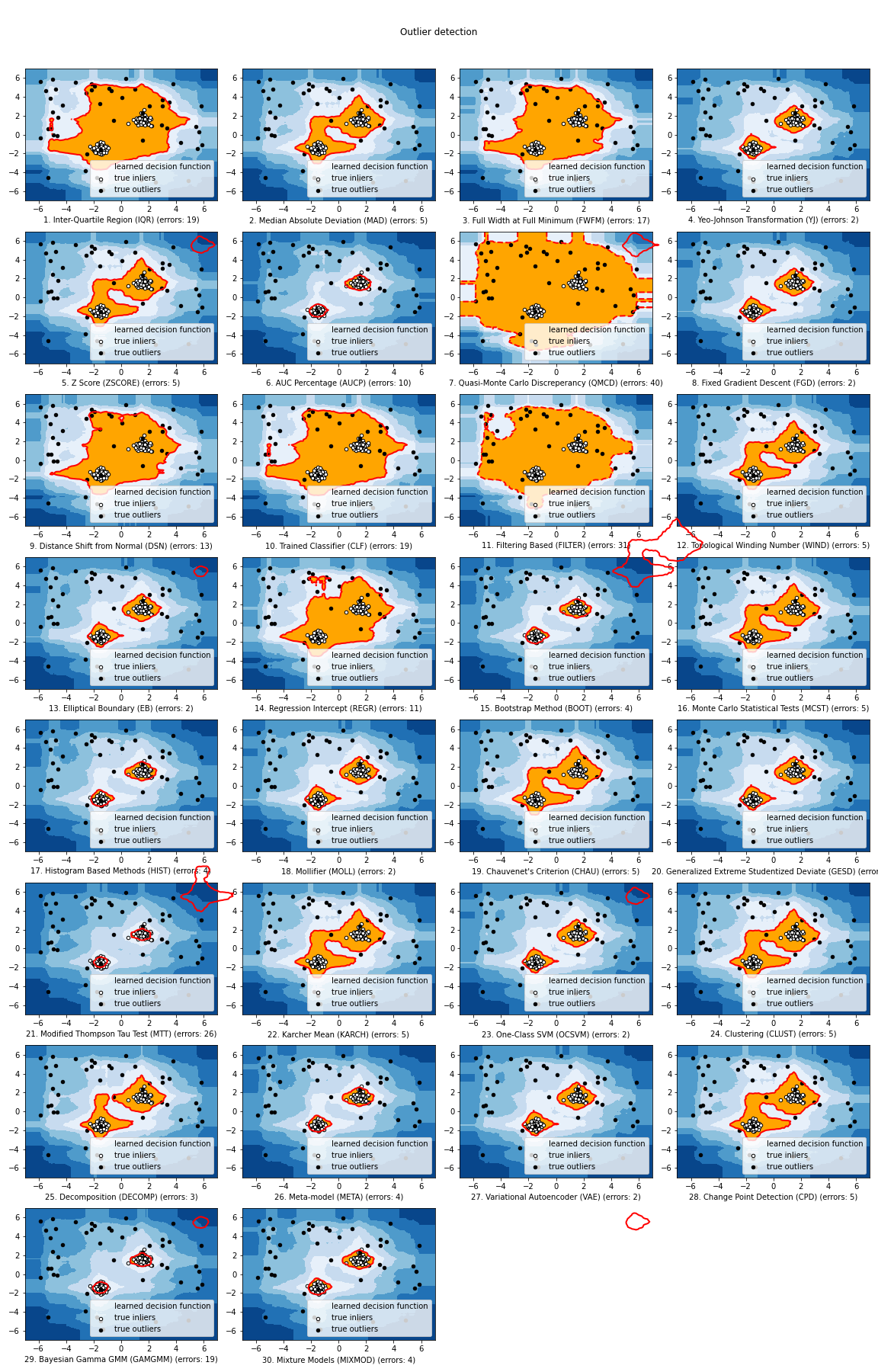A Python Toolbox for Outlier Detection Thresholding
Project description
Deployment, Stats, & License






PyThresh is a comprehensive and scalable Python toolkit for thresholding outlier detection scores in univariate/multivariate data. It has been writen to work in tandem with PyOD with similar syntax and data structures. However, it is not limited to this single library to achieve good results. PyThresh is meant to threshold scores generated by an outlier detection. It thresholds scores without the need to set a contamination level or have the user guess the amount of outliers that may exist in the dataset beforehand. These non-parametric methods were written to reduce the user’s input/guess work and rely on statistics instead to threshold outlier scores. The scores needed to apply thresholing correctly must follow these rules: the higher the score, the higher the probability that it is an outlier in the dataset. All threshold functions return a binary array where 0 values represent inliers, while 1 values are outliers.
PyThresh includes more than 30 thresholding algorithms. These algorithms range from using simple statistical analysis like the Z-score to more complex mathematical methods that involve graph theory and topology.
Outlier Detection Thresholding with 7 Lines of Code:
# train the KNN detector
from pyod.models.knn import KNN
from pythresh.thresholds.dsn import DSN
clf = KNN()
clf.fit(X_train)
# get outlier scores
decision_scores = clf.decision_scores_ # raw outlier scores on the train data
# get outlier labels
thres = DSN()
labels = thres.eval(decision_scores)Installation
It is recommended to use pip for installation:
pip install pythresh # normal install
pip install --upgrade pythresh # or update if neededAlternatively, you could clone and run setup.py file:
git clone https://github.com/KulikDM/pythresh.git
cd pythresh
pip install .Required Dependencies:
geomstats
matplotlib
numpy>=1.13
pyod
scipy>=1.3.1
scikit_learn>=0.20.0
six
API Cheatsheet
eval(score): evaluate outlier score.
Key Attributes of threshold:
thresh_: Return the threshold value that seperates inliers from outliers. Outliers are considered all values above this threshold value. Note the threshold value has been derived from normalized scores.
Implemented Algorithms
(i) Individual Thresholding Algorithms :
Abbr |
Description |
Parameters |
|---|---|---|
AUCP |
Area Under Curve Precentage [1] |
None |
BOOT |
Bootstrapping [2] |
None |
CHAU |
Chauvenet’s Criterion [3] |
method: [default=’mean’, ‘median’, ‘gmean’] |
CLF |
Trained Classifier [4] |
None |
DSN |
Distance Shift from Normal [5] |
metric: [default = ‘JS’: Jensen-Shannon, ‘WS’: Wasserstein, ‘ENG’: Energy, ‘BHT’: Bhattacharyya, ‘HLL’: Hellinger, ‘HI’: Histogram intersection, ‘LK’: Lukaszyk–Karmowski metric for normal distributions, ‘LP’: Levy-Prokhorov, ‘MAH’: Mahalanobis, ‘TMT’: Tanimoto, ‘RES’: Studentized residual distance, ‘KS’: Kolmogorov–Smirnov] |
EB |
Elliptical Boundary [6] |
None |
FGD |
Fixed Gradient Descent [7] |
None |
FILTER |
Filtering Based [8] |
method: [‘gaussian’, ‘savgol’, ‘hilbert’, default = ‘wiener’, ‘medfilt’, ‘decimate’, ‘detrend’, ‘resample’]; sigma: int, default=’native’ |
FWFM |
Full Width at Full Minimum [9] |
None |
GESD |
Generalized Extreme Studentized Deviate [10] |
max_outliers: int, default=’native’; alpha: float, default=0.05 |
HIST |
Histogram Based [11] |
n_bins: int, default=’native’, method: [default=’otsu’, ‘yen’, ‘isodata’, ‘li’, ‘minimum’, ‘triangle’] |
IQR |
Inter-Qaurtile Region [12] |
None |
KARCH |
Karcher mean (Riemannian Center of Mass) [13] |
ndim: int, default = 2; method: [‘simple’, default = ‘complex’] |
KMEANS |
K-means Clustering [14] |
None |
MAD |
Median Absolute Deviation [15] |
None |
MCST |
Monte Carlo Shapiro Tests [16] |
None |
MOLL |
None |
|
MTT |
Modified Thompson Tau Test [19] |
strictness: [1,2,3,default=4,5] |
QMCD |
Quasi-Monte Carlo Discreprancy [20] |
method: [‘CD’, default=’WD’, ‘MD’, ‘L2-star’], lim: [‘Q’, default=’P’] |
REGR |
Regression Based [21] |
method: [default=’siegel’, ‘theil’] |
SHIFT |
Mean Shift Clustering [22] |
None |
WIND |
Topological Winding Number [23] |
None |
YJ |
Yeo-Johnson Transformation [24] |
None |
ZSCORE |
Z-score [25] |
None |
ALL |
All Thresholders Combined |
thresholders: list, default=’all’; max_contam: float, default=0.5; method: [default=’mean’, ‘median’, ‘gmean’] |
Implementations & Benchmarks
The comparison among implemented models and general implementation is made available below
For Jupyter Notebooks, please navigate to notebooks.
A quick look at all the thresholders performance can be found at “/notebooks/Compare All Models.ipynb”

References
Please Note not all references’ exact methods have been employed in PyThresh. Rather, the references serve to demonstrate the validity of the threshold types available in PyThresh.
Project details
Release history Release notifications | RSS feed
Download files
Download the file for your platform. If you're not sure which to choose, learn more about installing packages.
Source Distribution
File details
Details for the file pythresh-0.2.1.tar.gz.
File metadata
- Download URL: pythresh-0.2.1.tar.gz
- Upload date:
- Size: 27.8 kB
- Tags: Source
- Uploaded using Trusted Publishing? No
- Uploaded via: twine/4.0.0 CPython/3.9.10
File hashes
| Algorithm | Hash digest | |
|---|---|---|
| SHA256 | 6075b39d6469b4600d1022787999e48ef01098ec2576ce9aa03c6561007784bc |
|
| MD5 | a07817d371d13495c1d301e1d0446b58 |
|
| BLAKE2b-256 | 308e9886485dd1772096f0c605a56ba07004ba0c10c1023f7559319ae43204be |











